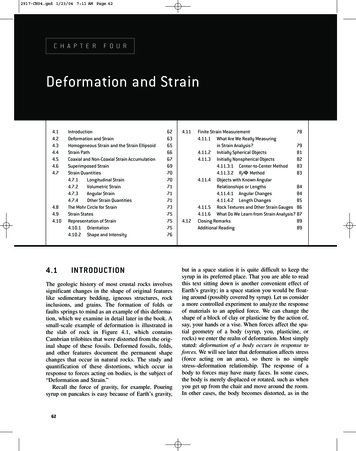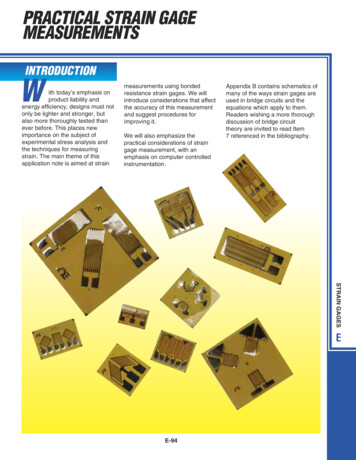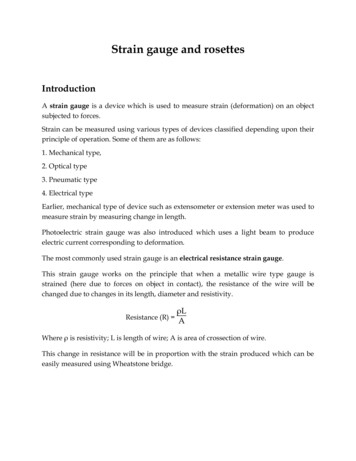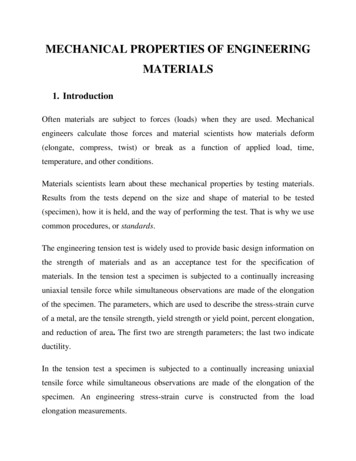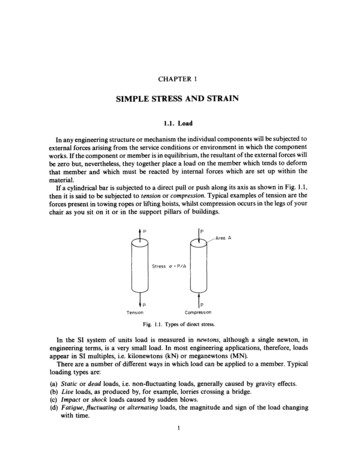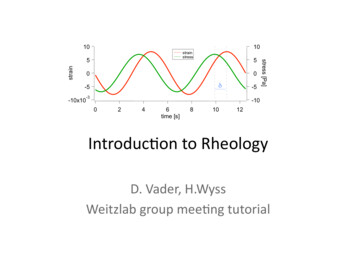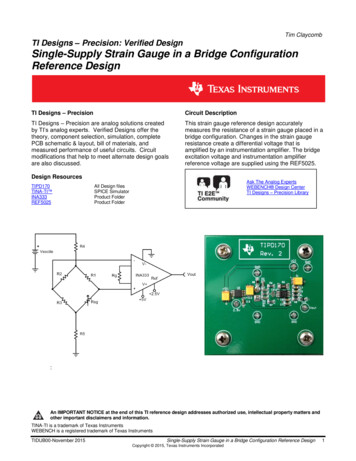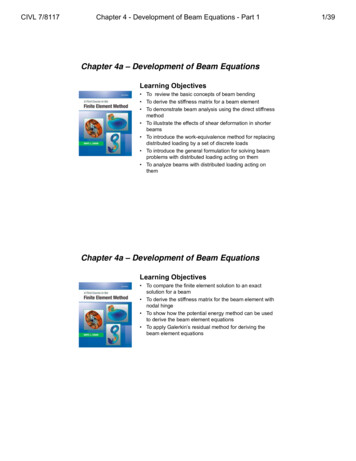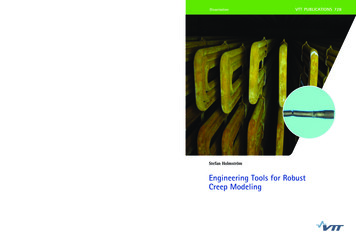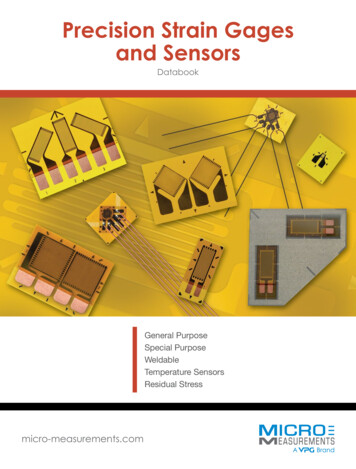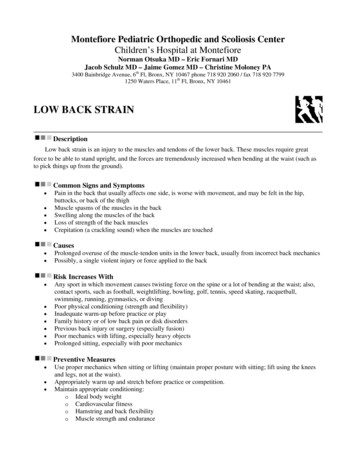
Transcription
Montefiore Pediatric Orthopedic and Scoliosis CenterChildren’s Hospital at MontefioreNorman Otsuka MD – Eric Fornari MDJacob Schulz MD – Jaime Gomez MD – Christine Moloney PA3400 Bainbridge Avenue, 6th Fl, Bronx, NY 10467 phone 718 920 2060 / fax 718 920 77991250 Waters Place, 11th Fl, Bronx, NY 10461LOW BACK STRAINDescriptionLow back strain is an injury to the muscles and tendons of the lower back. These muscles require greatforce to be able to stand upright, and the forces are tremendously increased when bending at the waist (such asto pick things up from the ground).Common Signs and Symptoms Pain in the back that usually affects one side, is worse with movement, and may be felt in the hip,buttocks, or back of the thighMuscle spasms of the muscles in the backSwelling along the muscles of the backLoss of strength of the back musclesCrepitation (a crackling sound) when the muscles are touchedCauses Prolonged overuse of the muscle-tendon units in the lower back, usually from incorrect back mechanicsPossibly, a single violent injury or force applied to the backRisk Increases With Any sport in which movement causes twisting force on the spine or a lot of bending at the waist; also,contact sports, such as football, weightlifting, bowling, golf, tennis, speed skating, racquetball,swimming, running, gymnastics, or divingPoor physical conditioning (strength and flexibility)Inadequate warm-up before practice or playFamily history or of low back pain or disk disordersPrevious back injury or surgery (especially fusion)Poor mechanics with lifting, especially heavy objectsProlonged sitting, especially with poor mechanicsPreventive Measures Use proper mechanics when sitting or lifting (maintain proper posture with sitting; lift using the kneesand legs, not at the waist).Appropriately warm up and stretch before practice or competition.Maintain appropriate conditioning:o Ideal body weighto Cardiovascular fitnesso Hamstring and back flexibilityo Muscle strength and endurance
Expected OutcomeThis condition is usually curable, with appropriate conservative treatment, within 6 weeks.Possible Complications Frequent recurrence of symptoms, resulting in a chronic problem; appropriately addressing the problemthe first time decreases frequency of recurrenceChronic inflammation, scarring, and partial muscle-tendon tearDelayed healing or resolution of symptomsProlonged disabilityGeneral Treatment ConsiderationsThe injury to the back results in pain and inflammation. The pain and inflammation result in muscle spasmsof the back muscles, which in turn result in more pain. Thus the initial treatment consists of rest, medications,and ice to relieve pain, inflammation, and muscle spasms. As pain and spasms subside, exercises to improvestrength and flexibility and proper back mechanics are started. Referral to a physical therapist or athletic trainermay be recommended for these exercises, education regarding back mechanics, and possibly other treatments,such as transcutaneous electronic nerve stimulation (TENS) or ultrasound. A corset or back brace (low back)may be recommended. Biofeedback and psychotherapy may also be prescribed. Prolonged bed rest is felt to beof more harm than good at this time. Bending your knees to pick things up off the ground (as opposed tobending at the waist), laying flat on your back on a firm mattress with a pillow under your knees, and usinggood posture when sitting are helpful. Occasionally an injection of cortisone, with or without local anesthetics,may be administered to help relieve the pain and spasms.Medication Nonsteroidal anti-inflammatory medications, such as aspirin and ibuprofen (do not take within 7 daysbefore surgery), or other minor pain relievers, such as acetaminophen, are often recommended. Takethese as directed by your physician. Contact your physician immediately if any bleeding, stomach upset,or signs of an allergic reaction occur.Topical ointments may be of benefit.Pain relievers and muscle relaxants may be prescribed as necessary by your physician. Use only asdirected and only as much as you need. Do not use any heavy machinery or drive a car while on thesemedications.Oral corticosteroids or injections of corticosteroids into the spot of the most muscle spasms or painoccasionally may be administered.Heat and Cold Cold is used to relieve pain and reduce inflammation for acute and chronic cases. Cold should beapplied for 10 to 15 minutes every 2 to 3 hours for inflammation and pain and immediately after anyactivity that aggravates your symptoms. Use ice packs or an ice massage.Heat may be used before performing stretching and strengthening activities prescribed by yourphysician, physical therapist, or athletic trainer. Use a heat pack or a warm soak.Notify Our Office If Symptoms get worse or do not improve in 2 to 4 weeks despite treatmentYou develop numbness, weakness, or loss of bowel or bladder functionNew, unexplained symptoms develop (drugs used in treatment may produce side effects)
RANGE OF MOTION AND STRETCHING EXERCISES Low Back StrainThe exact range of motion and stretching exercises appropriate for you usually need to be determined on an individualbasis. Some individuals respond better to flexion (pulling your knees to your chest), whereas others respond better toextension (placing an arch in your back). The key point to remember is that if any exercise (range of motion, stretching,or strengthening) causes pain to radiate away from your back and toward your buttocks or legs, stop immediately. Thepurpose of these exercises is to begin to decrease the intensity and the size of the area of your pain.These are some of the initial exercises you may start your rehabilitation program with until you see your physician,physical therapist, or athletic trainer again or until your symptoms are resolved. Flexion and extension exercises arepresented. The specific exercises that are appropriate for you must be specified by your physician, physical therapist,or athletic trainer before you start them. Please remember: Flexible tissue is more tolerant of the stresses placed on it during activities. Each stretch should be held for 20 to 30 seconds. A gentle stretching sensation should be felt. If pain or other symptoms radiate away from the back toward the buttocks or legs, stop the exercisesimmediately.LUMBAR EXTENSION Prone on ElbowsLUMBAR FLEXION Single Knee to Chest1. Lie on your back with both legs flat on the floor.2. Bend one hip and knee up toward your chest.3. Grasp knee with your hand(s) and pull it gentlytoward your chest.4. Keep the other leg flat on the floor while doing thisexercise.5. Repeat with the opposite side.6. Repeat exercise 5 times, 2 times per day. Hold eachrepetition 5 to 10 seconds.1. Lie on your stomach on the floor.2. Place your arms underneath you and “prop” up onyour elbows as shown.3. Allow your back to relax and sag. Hold this positionfor 30 to 45 seconds.4. Return to your starting position, lying on yourstomach, flat on the floor.5. Repeat exercise 3 times, 2 times per day.LUMBAR FLEXION Double Knee to Chest1. Lie on your back with both legs flat on the floor.2. Bend one hip and knee up toward your chest and thenthe other.3. Grasp your knees with your hands and pull themgently toward your chest.4. Hold this stretch position for 5 to 10 seconds.6. Repeat exercise 5 times, 2 times per day.
LUMBAR EXTENTION Prone Press Ups1. Lie on your stomach on the floor as shown in thepicture.2. Place your palms flat on the floor. Push down on yourhands, straightening out your arms and putting anarch in your back. Straighten your elbows fully, whilekeeping your hips on the floor.3. Return to your starting position.4. If you are unable to fully straighten your elbowswhile keeping your back relaxed, place your handsfarther in front of you and try again.5. Repeat exercise 5 times 2 times per day. Hold eachrepetition 5 to 10 seconds.LUMBAR ROTATION1 Lie on your back with your hips and knees bent, feetflat on the floor.2. Keep your arms out at your sides and your shouldersflat on floor.3. Rotate hips and knees to one side as far as you canwhile keeping arms and shoulders flat on floor. Holdthis position for 5 seconds.4. Reverse position and rotate your hips and knees to theopposite side. Hold this position for seconds.5. Repeat exercise 10 times, 2 times per day.LUMBAR NEUTRAL POSITION1. Position yourself on your hands and knees as shown.2. Tighten your stomach muscles and tuck yourpelvis/hips under, arching your back as shown in thediagram. Hold this position for5 seconds.3. Tighten your back muscles, rotating your buttocks upand allowing your back to arch/sag as shown. Holdthis position for 5 seconds.4. Find a middle/neutral position. Tighten your stomachand back muscles. Hold this position for 5 seconds.5. Repeat exercise 10 times, 2 times per day.
STRENGTHENING EXERCISES Low Back StrainThese are some of the initial exercises you may start your rehabilitation program with until you see your physician,physical therapist, or athletic trainer again or until your symptoms are resolved. Please remember: Strong muscles with good endurance tolerate stress better. Do the exercises as initially prescribed by your physician, physical therapist, or athletic trainer. Progressslowly with each exercise, gradually increasing the number of repetitions and weight used under theirguidance. If pain or other symptoms radiate away from the back toward the buttocks or legs stop the exercisesimmediately.QUADRIPED Opposite UE/LE LiftPELVIC TILT1. Lie on the floor as shown. You may do this exercisewith your knee bent or straight. It is harder with theknees straight.2. Tighten your stomach and buttock muscles and pushback flat onto floor. If you do this properly yourpelvis will rotate in the direction shown in thediagram. Hold each repetition 15 to 20 seconds.3. Repeat exercise 5 times 2 times per day. Do not holdyour breath. Count out loud!PARTIAL SIT UPs1. Lie flat on your back with your hands resting on yourthighs.2. Tuck your chin to your chest.3. Slowly sit up until you touch the top of your knees.4. Hold this position for a count of 15. Count out loud.Do not hold your breath!5. Return to the starting position.6. Repeat exercise 5 times, 2 times per day.1. Position yourself on your hands and knees.2. Keep your back flat and parallel to the floor. Do notallow it to arch or move during this exercise.3. Lift your left arm up to shoulder height. Hold thisposition and lift your right leg to the same height.4. Balance and hold this position for 15 to 30 seconds.5. Return to starting position and repeat with theopposite arm and leg.6. Repeat exercise 5 times, 2 times per day. Do not holdyour breath. Count out loud.DOUBLE LEG HOLD1. Lie on your back with your hips and knees bent.2. Bend your legs/hips toward you as shown.3. Tighten your stomach muscles and press your backflat into the floor.4. While keeping your back flat on the floor, slowly letyour legs back down. When you feel your back startto arch, stop and hold that position. Count out loud to15. Do not hold your breath!5. Return to the starting position.6. Repeat exercise 5 times, 2 times per day.
POSTURE AND BODY MECHANICS CONSIDERATIONS Low Back StrainMaintaining the most appropriate posture and using correct body mechanics can have a significant effect on back pain.The following are basic suggestions regarding proper posture and body mechanics. These should be specificallydiscussed with your physician, physical therapist, or athletic trainer. Please remember: Good posture minimizes the stress and strain on any portion of your spine. Do the exercises as initially prescribed by your physician, physical therapist, or athletic trainer. Incorporate these exercises and posture principles into all of your daily and recreational activities.RESTING POSITIONSSleep or rest on a firm surface. Find a position ofcomfort. The most commonly suggested positions aresidelying with a pillow between your knees or on yourback with a pillow under your knees.PROPER SITTING POSTUREDo not slouch sit! Sit with a small rolled-up towel, foamcushion, or pillow in your low-back area, just above yourbelt. Sit with your buttocks all the way back in the chair.CORRECT LIFTING TECHNIQUESDO: Lift with your legs, keeping your back straight. Use a footstool for objects that need to beplaced or retrieved from high locations. Use two people for heavy or awkward objects.INCORRECT LIFTING TECHNIQUESDO NOT: Lift with your legs straight and your backflexed/bent. Lift objects that are too heavy over your head. Ever lift and twist at the same time. Lift an object that is too heavy or awkwardlyshaped without help.
CORRECT STANDING POSTURESStand upright and erect whenever possible.SLOUCHINGAvoid slouching when you walk or stand. Stand upstraight. Walk erect and tall.LIFTINGDo not round out your back when lifting any object. Youshould make sure that you bend your knees and attemptto maintain a normal curve in your spine.INCORRECT SITTING POSTURESDo not slouch or slump. Maintain a properposition in the chair.CORRECT SITTING POSTURESSit Erect. Use a lumbar roll, cushion, or pillow. Use achair that has a high enough back to support your backup to your shoulder blades.Copyright 2003, Elsevier Science (USA). All RightsReserved.
The pain and inflammation result in muscle spasms of the back muscles, which in turn result in more pain. Thus the initial treatment consists of rest, medications, and ice to relieve pain, inflammation, and muscle spasms. As pain and spasms subside, exercises to improve strength and flexibility and proper back mechanics are started.
